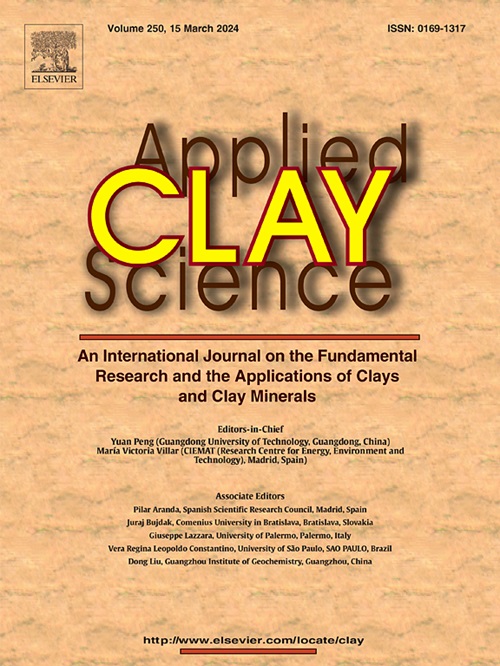通过三轴试验研究压实怀俄明型膨润土随盐度变化的极限剪切强度
IF 5.8
2区 地球科学
Q2 CHEMISTRY, PHYSICAL
引用次数: 0
摘要
乏核燃料贮存库地下水中的离子成分是预测膨润土缓冲层剪切行为的一个不确定因素。然而,只有少数研究调查了剪切强度随原位地下水条件变化的范围。本文研究了压实怀俄明型膨润土的极限剪切强度,重点关注孔隙水盐度的影响。在有效约束压力高达 10 兆帕的条件下进行了三轴试验,孔隙水代表了不同的类型:同时跟踪可交换阳离子成分的演变。结果表明,库区具有典型 Ca2+ 浓度的孔隙水可通过 Na+-Ca2+ 阳离子交换强化钠基膨润土。观察到的膨润土强度随盐度变化的情况是通过极限剪切强度线及其在偏离应力-平均有效应力平面上的明显移动来描述的。结果发现,强度增加的上限为 0.74 兆帕。对比了之前使用去离子水进行的三轴试验结果,以完善极限剪切强度线的形状。本文阐明了从饱和膨润土三轴测试中汲取的经验教训,为应对与高膨胀潜能值和低渗透性相关的挑战提供了建议。本文的研究结果对准确评估深层地质弃置系统中的剪切行为以及在实验室中有效测量压实膨润土的剪切强度参数具有重要意义。本文章由计算机程序翻译,如有差异,请以英文原文为准。
Salinity-dependent ultimate shear strength of compacted Wyoming-type bentonite investigated by triaxial tests
Ion composition in groundwater at the spent nuclear fuel repositories is a relevant uncertainty for predicting the shear behavior of the bentonite buffer. However, only a few studies investigated the range of shear strength variation with in-situ groundwater conditions. This paper examines the ultimate shear strength of compacted Wyoming-type bentonite, focusing on the effect of pore water salinity. Triaxial tests were performed under effective confining pressures up to 10 MPa with different types of pore water representing: 1) extremely low, 2) current, and 3) maximal salinity conditions at the repositories, while tracking the evolution of exchangeable cation composition. The results revealed that pore waters with typical Ca2+ concentrations at the repositories strengthen the sodium bentonite through Na+-Ca2+ cation exchange. The observed salinity-dependent strength of the bentonite was described by the ultimate shear strength line and its apparent mobilization in the deviatoric stress-mean effective stress plane. The upper limit of the increase in strength was found to be 0.74 MPa. Previous triaxial test results with deionized water were compared to refine the shape of the ultimate shear strength line. Lessons learned from the triaxial testing of saturated bentonite were elucidated to offer recommendations to address the challenges associated with high swelling potential and low permeability. The findings in this paper have implications for accurate assessment of shear behavior in the deep geological disposal system as well as effective laboratory measurements of the shear strength parameters of compacted bentonite.
求助全文
通过发布文献求助,成功后即可免费获取论文全文。
去求助
来源期刊

Applied Clay Science
地学-矿物学
CiteScore
10.30
自引率
10.70%
发文量
289
审稿时长
39 days
期刊介绍:
Applied Clay Science aims to be an international journal attracting high quality scientific papers on clays and clay minerals, including research papers, reviews, and technical notes. The journal covers typical subjects of Fundamental and Applied Clay Science such as:
• Synthesis and purification
• Structural, crystallographic and mineralogical properties of clays and clay minerals
• Thermal properties of clays and clay minerals
• Physico-chemical properties including i) surface and interface properties; ii) thermodynamic properties; iii) mechanical properties
• Interaction with water, with polar and apolar molecules
• Colloidal properties and rheology
• Adsorption, Intercalation, Ionic exchange
• Genesis and deposits of clay minerals
• Geology and geochemistry of clays
• Modification of clays and clay minerals properties by thermal and physical treatments
• Modification by chemical treatments with organic and inorganic molecules(organoclays, pillared clays)
• Modification by biological microorganisms. etc...
 求助内容:
求助内容: 应助结果提醒方式:
应助结果提醒方式:


